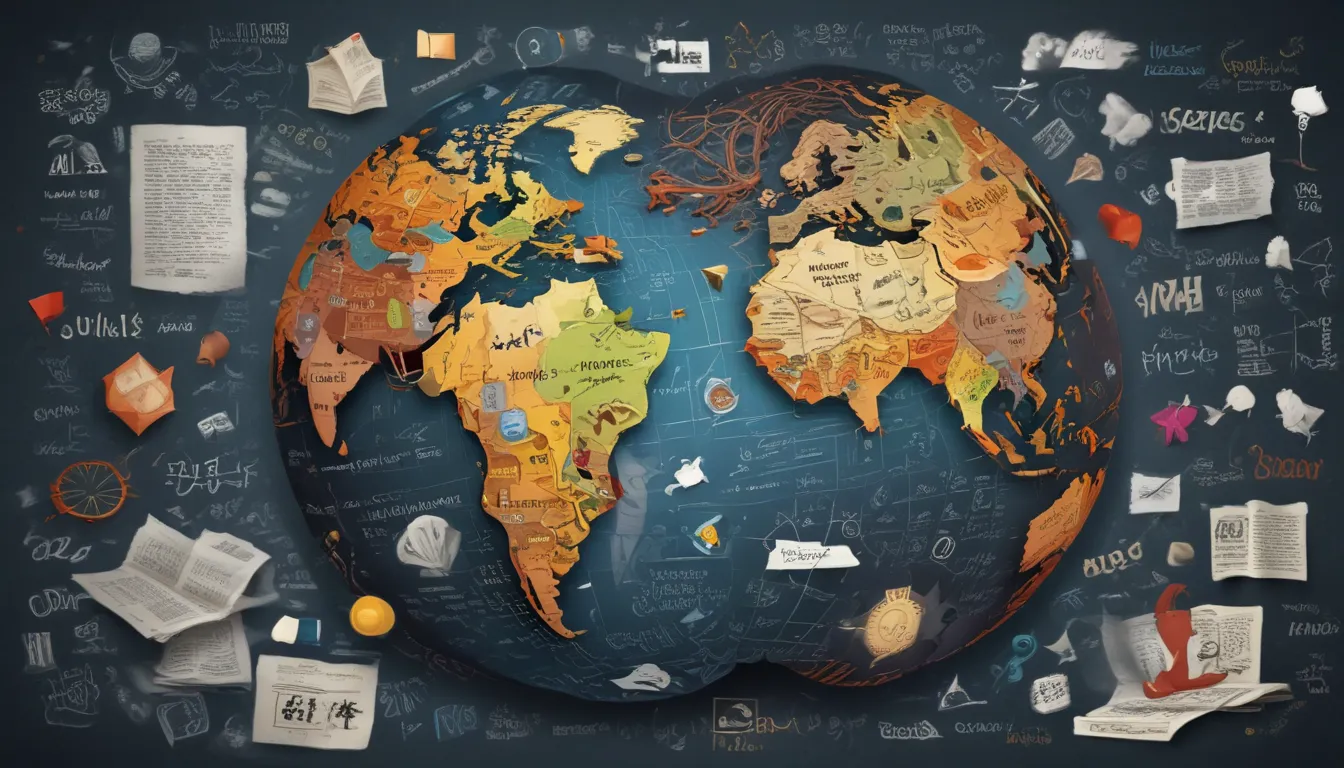A Note About Images: The images used in our articles are for illustration purposes only and may not exactly match the content. They are meant to engage readers, but the text should be relied upon for accurate information.
Translation is a captivating field that serves as a vital link between languages and cultures, playing a significant role in fostering global understanding and cooperation. It goes beyond mere word substitution, encompassing the essence and nuances of the original message to effectively convey ideas. In this article, we’ll delve into 15 captivating facts about translation that shed light on its intricacies and challenges, offering valuable insights into this ever-evolving art. Whether you’re curious about the world of translation or looking to expand your knowledge, read on to discover some fascinating aspects of this essential discipline.
The Ancient Practice of Translation
Translation dates back thousands of years, with historical texts like the Bible being translated into multiple languages to promote wider accessibility and understanding. This long-standing tradition highlights the enduring importance of translation in communication and knowledge dissemination.
The Global Linguistic Diversity
With over 7,000 languages spoken worldwide, the demand for skilled translators who can navigate between different languages and cultures is higher than ever. This rich linguistic landscape underscores the significance of translation in facilitating cross-cultural communication and exchange.
The Art of Effective Translation
Translation transcends mere word-for-word conversion, encompassing the context, cultural nuances, and essence of the source language to convey the message accurately in the target language. It requires a deep understanding of both languages and cultures to ensure effective communication.
Interpretation: Real-Time Translation
Interpretation, a form of translation, focuses on converting spoken language in real-time, commonly used in settings like conferences, courtrooms, and diplomatic exchanges. This dynamic aspect of translation underscores the versatility and agility required in the field.
The Rise of Machine Translation
Advancements in technology have given rise to machine translation tools like Google Translate, which automatically translate text between languages. However, while machine translation aids efficiency, human translators remain indispensable for ensuring accuracy and quality in translations.
Transcreation: Merging Translation and Creativity
Transcreation involves adapting a message from one language to another while considering cultural differences, humor, idioms, and other creative elements to ensure the desired impact on the target audience. This fusion of translation and creativity adds depth and resonance to the translated content.
Localization: Tailoring Content for Specific Cultures
Localization goes beyond translation by adapting content to fit a specific culture or locale, considering cultural references, currency, date formats, and even color associations. This nuanced approach ensures that the content resonates with the target audience on a deeper level.
The Growing Demand for Translation Skills
In our globally interconnected world, professionals with language skills and translation expertise have a competitive advantage across various industries, including business, healthcare, tourism, and international relations. The ability to bridge language barriers is a valuable asset in today’s diverse marketplace.
Specialized Expertise in Translation
Translators often specialize in specific fields like medicine, law, finance, or technology to accurately translate specialized and technical content. This specialization ensures the use of industry-specific terminology and maintains accuracy in translations.
Translation in Diplomacy and International Relations
Translation plays a pivotal role in facilitating diplomatic communication, negotiations, and fostering international cooperation by ensuring accurate and culturally appropriate translations of crucial documents and speeches. It contributes significantly to building mutual understanding among nations.
The United Nations as a Translation Hub
With six official languages, the United Nations relies on a vast team of translators to facilitate effective communication among member countries and ensure multilingual accessibility of its documents and conferences. The UN serves as a prominent employer of translation professionals worldwide.
Challenges Faced by Translators
Translators encounter complex challenges such as capturing cultural nuances, idiomatic expressions, and humor, highlighting the need for a profound understanding of both the source and target languages. Overcoming these challenges requires expertise and sensitivity to cultural subtleties.
Tools of the Trade for Translators
Translators utilize various tools such as translation memory software, glossaries, style guides, and terminology databases to enhance consistency, accuracy, and efficiency in their work. These tools aid in managing terminology and ensuring quality in translations.
Proofreading and Editing in Translation
After the initial translation process, proofreading and editing play a critical role in ensuring the quality, coherence, and correctness of the final translated output. This meticulous review process is essential for delivering accurate and polished translations.
Translation for Cultural Exchange and Understanding
Translation enables the sharing of ideas, literature, and diverse cultural expressions, fostering global understanding, appreciation, and respect for different cultures and their unique contributions. It serves as a bridge for connecting people from diverse backgrounds and promoting cross-cultural dialogue.
Conclusion: Embracing the Power of Translation
In conclusion, translation emerges as a fascinating and vital aspect of human communication, essential for bridging language barriers and fostering mutual understanding among diverse communities. From its role in diplomacy to its impact on cultural exchange, translation plays a crucial role in enabling effective communication across languages. As the world continues to globalize, the demand for accurate and efficient translation services will continue to rise, highlighting the enduring significance of this indispensable art form.
FAQs: Addressing Common Questions About Translation
-
Why is translation important?
Translation allows people with different languages to understand and communicate with each other, promoting cultural exchange, facilitating international business, and enabling access to information from diverse regions. -
What is the difference between translation and interpretation?
Translation involves the written conversion of text from one language to another, while interpretation focuses on orally conveying spoken words or sign language in real-time. -
How long does it take to become a professional translator?
The time required to become a professional translator varies based on factors like language ability, educational background, and experience, ranging from several months to several years. -
Can translation be done by machines?
While machine translation has made significant advances, human translators are crucial for ensuring accurate and nuanced translations. Machines can assist in the process, but human expertise is essential for high-quality translations. -
What are the challenges faced by translators?
Translators encounter challenges like cultural nuances, idiomatic expressions, technical terminology, and maintaining the original text’s intended meaning, requiring strong linguistic skills and cultural understanding to overcome. -
How does translation technology impact the translation process?
Translation technology enhances translator productivity and consistency through tools like computer-assisted translation and machine translation systems. These tools aid in terminology management and quality control. -
Is it necessary for a translator to be bilingual?
While fluency in at least two languages is essential for translators, strong writing skills, subject matter expertise, and cultural understanding are also necessary to produce accurate translations. -
What is simultaneous interpretation?
Simultaneous interpretation involves an interpreter delivering real-time translations while the speaker is still speaking, commonly used in conferences with the aid of interpretation booths and specialized equipment. -
Are there different translation techniques?
Various translation techniques, such as literal translation, idiomatic translation, localization, transcreation, and adaptation, are employed based on the text’s nature and desired outcome. -
Can a translated text convey the same emotional impact as the original?
While translating emotions accurately can be challenging, skilled translators strive to capture the original intent and evoke similar emotional responses in the target language, requiring an understanding of cultural nuances. -
How can I find a professional translator?
Professional translators can be found through translation agencies, freelance platforms, or professional associations. It’s essential to assess their qualifications, experience, and client reviews before engaging their services for translation needs.
Empowering Learning Through Trustworthy Content
At the heart of our commitment to delivering valuable insights lies the dedication to providing trustworthy and engaging content. Each fact on this site is contributed by real users, ensuring a diverse and credible range of information. Our meticulous editorial process guarantees the highest standards of accuracy and reliability, offering you a wealth of insights to explore and learn with confidence. Trust in our unwavering commitment to quality and authenticity as you embark on your journey of discovery through the fascinating world of translation.






